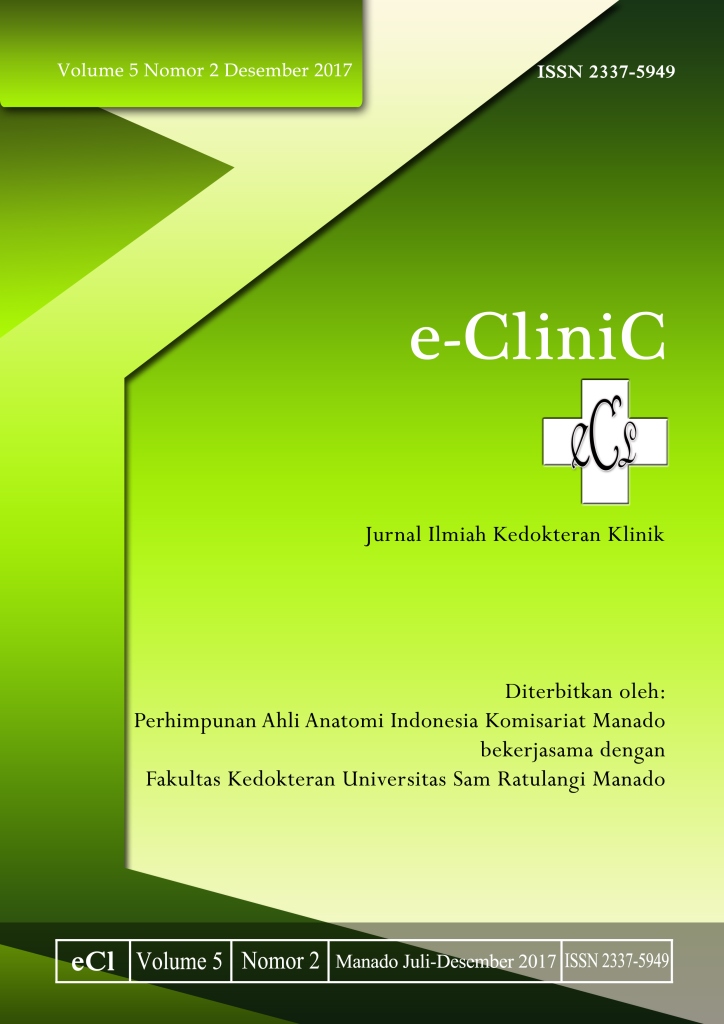Profil Pasien Pasca Kraniotomi di ICU RSUP Prof. Dr. R. D. Kandou Manado Periode Juli 2016 - Juni 2017
DOI:
https://doi.org/10.35790/ecl.v5i2.18541Abstract
Abstract: Craniotomy is a surgical action by opening the skull bone to provide direct access to the brain. Craniotomy can be performed in patients suffering from brain tumors, cerebral hemorrhage, cerebral aneurysms, cerebral infection, and brain trauma. This study was aimed to obtain the profile of post craniotomy patients at ICU Prof. Dr. R. D. Kandou Hospital Manado from July 2016 to June 2017. This was a descriptive retrospective study using medical record data of post craniotomy patients at Prof. Dr. R. D. Kandou Manado. There were 30 post craniotomy patients at the ICU. The majority of them had traumatic brain injury as the underlying disease (77%), males (90%), and aged 15-24 years old (37%). Many post craniotomy patients used mechanical ventilators (80%) with prolonged use >72 hours (46%). The average lengh of post craniotomy care in ICU was 2 days (27%). Eleven patients (36%) died at >72 hours treated in ICU and caused by sepsis (55%). The average Glasgow coma scale preoperative was 8-12 (57%) and the physical status according to the American society of Anesthesiologist (ASA) was III E (67%). Conclusion: Most post craniotomy patients were 15-24 years old, male, traumatic brain injury as the underlying disease of craniotomy, duration in ICU 2 days. A part of the patients died due to sepsis. Many post craniotomy patients used mechanical ventilators > 72 hours. The majority had preoperative Glasgow coma scale of 8-12 and the highest ASA physical status were III E.
Keywords: craniotomy, ventilator, traumatic brain injury, mortality
Â
Abstrak: Kraniotomi adalah tindakan pembedahan dengan membuka tulang tengkorak untuk memberikan akses secara langsung ke otak. Kraniotomi dapat dilakukan pada pasien yang menderita tumor otak, perdarahan otak, aneurisma serebri, infeksi otak, serta trauma otak. Penelitian ini bertujuan untuk mengetahui profil pasien pasca kraniotomi di ICU RSUP Prof. Dr. R. D. Kandou Manado periode Juli 2016 – Juni 2017. Jenis penelitian ialah deskriptif retrospektif, menggunakan data rekam medik pasien pasca kraniotomi di RSUP Prof. Dr. R. D. Kandou Manado. Hasil mendapatkan 30 orang pasca kraniotomi di ICU dengan penyakit yang mendasari terbanyak ialah cedera kepala (77%), jenis kelamin laki-laki (90%), dan usia 15-24 tahun (37%). Pasien pasca kraniotomi banyak yang menggunakan ventilator mekanik (80%) dengan lama penggunaan >72 jam (46%). Lama perawatan pasca kraniotomi di ICU rata-rata 2 hari (27%), 11 orang meninggal dunia (36%) pada >72 jam di rawat di ICU yang disebabkan oleh sepsis (55%). Rerata Glasgow Coma Scale preoperatif 8-12 (57 %) dan status fisik menurut American Society of Anesthesiologist (ASA) terbanyak III E (67%). Simpulan: Pasien pasca kraniotomi terbanyak pada usia 15-24 tahun, jenis kelamin laki-laki, penyakit mendasari kraniotomi ialah cedera kepala, dan lama rawat ICU 2 hari. Sebagian meninggal dengan penyebab utama sepsis. Pasien pasca kraniotomi banyak yang menggunakan ventilator mekanik dengan lama penggunaan > 72 jam. Glasgow Coma Scale preoperatif terbanyak pada 8-12 dan status fisik ASA terbanyak yaitu III E.
Kata kunci: kraniotomi, ventilator, cedera kepala, mortalitas
Downloads
How to Cite
Issue
Section
License
COPYRIGHT
Authors who publish with this journal agree to the following terms:
Authors hold their copyright and grant this journal the privilege of first publication, with the work simultaneously licensed under a Creative Commons Attribution License that permits others to impart the work with an acknowledgment of the work's origin and initial publication by this journal.
Authors can enter into separate or additional contractual arrangements for the non-exclusive distribution of the journal's published version of the work (for example, post it to an institutional repository or publish it in a book), with an acknowledgment of its underlying publication in this journal.
Authors are permitted and encouraged to post their work online (for example, in institutional repositories or on their website) as it can lead to productive exchanges, as well as earlier and greater citation of the published work (See The Effect of Open Access).







